Analyzing the Asymmetric Effect of Renewable Energy Consumption on Environment in STIRPAT-Kaya-EKC Framework: A NARDL Approach for China
Abstract
:1. Introduction
2. Literature Review
3. Data, Model and Methodology
3.1. Theoretical Framework
3.2. Econometric Strategy
4. Results and Discussion
4.1. Unit Root Test
4.2. Cointegration Analysis
4.3. NARDL Model Results
4.4. Stability Graph Results
5. Conclusions and Policy Recommendations
- The NARDL estimates of linear and quadratic terms of GDP support the EKC hypothesis in China in both the short-run and long-run, implying that the advantages of economic expansion in standings of CO2 secretions reduction will be realized over time.
- According to the findings, renewable energy has an asymmetric impact on environmental quality. However, results indicate that the negative shocks to renewable energy use have a greater damaging impression on the environment than the positive shock to renewable energy consumption. The decrease in the use of REC leaves the population to rely on non-renewable energy sources that cause a tremendous increase in CO2 emissions.
- It is also observed that the population contributes to environmental deprivation in the short run due to the resulting increase in demand for industrial products and transportation. However, its effect on environmental deterioration is insignificant in the long run.
- Technology proxied by the number of patent applications is found to improve the environment by shrinking the carbon releases in the long run, because the high-tech industries use energy-efficient and renewable energy-based technologies.
Author Contributions
Funding
Institutional Review Board Statement
Informed Consent Statement
Data Availability Statement
Conflicts of Interest
References
- Baumeister, S. We Are Still In! Conference report from the 2018 Ceres Conference. J. Clean. Prod. 2018, 196, 183–184. [Google Scholar] [CrossRef]
- Zhang-Wei, L.; Xun-Gang, Z. Study on Relationship of Energy Consumption and Economic Growth in China. Phys. Procedia 2012, 24, 313–319. [Google Scholar] [CrossRef] [Green Version]
- Collins, G. China’s Evolving Oil Demand: Slowing Overall Growth, Gasoline Replacing Diesel as Demand Driver, Refined Product Exports Rising Substantially. 2016. Available online: https://scholarship.rice.edu/bitstream/handle/1911/92692/WorkingPaper-ChinaOil-093016.pdf?sequence=1 (accessed on 28 April 2022).
- Eyuboglu, K.; Uzar, U. Asymmetric causality between renewable energy consumption and economic growth: Fresh evidence from some emerging countries. Environ. Sci. Pollut. Res. 2022, 29, 21899–21911. [Google Scholar] [CrossRef] [PubMed]
- Ehrlich, P.R.; Holdren, J.P. Impact of Population Growth: Complacency concerning this component of man’s predicament is unjustified and counterproductive. Science 1971, 171, 1212–1217. [Google Scholar] [CrossRef]
- Chontanawat, J. Decomposition analysis of CO2 emission in ASEAN: An extended IPAT model. Energy Procedia 2018, 153, 186–190. [Google Scholar] [CrossRef]
- Dawson, I.; Zhang, D. Using a 3D Interactive Model of the ‘IPAT’equation to Communicate What Can Drive Environment Risks. In Proceedings of the 29th Annual Conference of the Society for Risk Analysis—Europe, Espoo, Finland, 14–16 June 2021; Aalto University: Espoo, Finland. [Google Scholar]
- Fan, Y.; Liu, L.C.; Wu, G.; Wei, Y.M. Analyzing impact factors of CO2 emissions using the STIRPAT model. Environ. Impact Assess. Rev. 2006, 26, 377–395. [Google Scholar] [CrossRef]
- Filimonova, I.; Provornaya, I.; Komarova, A.; Zemnukhova, E.; Mishenin, M. Influence of economic factors on the environment in countries with different levels of development. Energy Rep. 2020, 6, 27–31. [Google Scholar] [CrossRef]
- Hubacek, K.; Feng, K.S.; Chen, B. Changing lifestyles towards a low carbon economy: An IPAT analysis for China. Energies 2012, 5, 22–31. [Google Scholar] [CrossRef]
- Kaya, Y. Impact of Carbon Dioxide Emission Control on GNP Growth: Interpretation of Proposed Scenarios. Intergovernmental Panel on Climate Change/Response Strategies Working Group, May 1989. Available online: https://cir.nii.ac.jp/crid/1570291225678384256 (accessed on 28 April 2022).
- Meyer, W.B.; Turner, B.L. Human population growth and global land-use/cover change. Annu. Rev. Ecol. Syst. 1992, 23, 39–61. [Google Scholar] [CrossRef]
- Grossman, G.M.; Krueger, A.B. Environmental Impacts of a North American Free Trade Agreement; MIT Press: Cambridge, MA, USA, 1991. [Google Scholar]
- Pao, H.-T.; Chen, C.C. Decoupling strategies: CO2 emissions, energy resources, and economic growth in the Group of Twenty. J. Clean. Prod. 2018, 206, 907–919. [Google Scholar] [CrossRef]
- Zoundi, Z. CO2 emissions, renewable energy and the Environmental Kuznets Curve, a panel cointegration approach. Renew. Sustain. Energy Rev. 2017, 72, 1067–1075. [Google Scholar] [CrossRef]
- Naz, S.; Sultan, R.; Zaman, K.; Aldakhil, A.M.; Nassani, A.A.; Abro, M.M.Q. Moderating and mediating role of renewable energy consumption, FDI inflows, and economic growth on carbon dioxide emissions: Evidence from robust least square estimator. Environ. Sci. Pollut. Res. 2018, 26, 2806–2819. [Google Scholar] [CrossRef] [PubMed]
- Hu, H.; Xie, N.; Fang, D.; Zhang, X. The role of renewable energy consumption and commercial services trade in carbon dioxide reduction: Evidence from 25 developing countries. Appl. Energy 2018, 211, 1229–1244. [Google Scholar] [CrossRef]
- Sarkodie, S.A.; Adams, S.; Owusu, P.A.; Leirvik, T.; Ozturk, I. Mitigating degradation and emissions in China: The role of environmental sustainability, human capital and renewable energy. Sci. Total Environ. 2020, 719, 137530. [Google Scholar] [CrossRef]
- Bölük, G.; Mert, M. Fossil & renewable energy consumption, GHGs (greenhouse gases) and economic growth: Evidence from a panel of EU (European Union) countries. Energy 2014, 74, 439–446. [Google Scholar]
- Hasnisah, A.; Azlina, A.A.; Che CM, I. The impact of renewable energy consumption on carbon dioxide emissions: Empirical evidence from developing countries in Asia. Int. J. Energy Econ. Policy 2019, 9, 135. [Google Scholar] [CrossRef]
- Nathaniel, S.P.; Iheonu, C.O. Carbon dioxide abatement in Africa: The role of renewable and non-renewable energy consumption. Sci. Total Environ. 2019, 679, 337–345. [Google Scholar] [CrossRef]
- Lin, B.; Moubarak, M. Renewable energy consumption—Economic growth nexus for China. Renew. Sustain. Energy Rev. 2014, 40, 111–117. [Google Scholar] [CrossRef]
- Dong, K.; Sun, R.; Jiang, H.; Zeng, X. CO2 emissions, economic growth, and the environmental Kuznets curve in China: What roles can nuclear energy and renewable energy play? J. Clean. Prod. 2018, 196, 51–63. [Google Scholar] [CrossRef]
- Bekhet, H.A.; Othman, N.S. The role of renewable energy to validate dynamic interaction between CO2 emissions and GDP toward sustainable development in Malaysia. Energy Econ. 2018, 72, 47–61. [Google Scholar] [CrossRef]
- Payne, J.E. The Causal Dynamics Between US Renewable Energy Consumption, Output, Emissions, and Oil Prices. Energy Sources Part B Econ. Plan. Policy 2012, 7, 323–330. [Google Scholar] [CrossRef]
- Silva, S.; Soares, I.; Pinho, C. The Impact of Renewable Energy Sources on Economic Growth and CO2 Emissions—A SVAR approach. Eur. Res. Stud. J. 2012, XV, 133–144. [Google Scholar] [CrossRef] [Green Version]
- Charfeddine, L.; Kahia, M. Impact of renewable energy consumption and financial development on CO2 emissions and economic growth in the MENA region: A panel vector autoregressive (PVAR) analysis. Renew. Energy 2019, 139, 198–213. [Google Scholar] [CrossRef]
- Nathaniel, S.; Anyanwu, O.; Shah, M. Renewable energy, urbanization, and ecological footprint in the Middle East and North Africa region. Environ. Sci. Pollut. Res. 2020, 27, 14601–14613. [Google Scholar] [CrossRef] [PubMed]
- Khattak, S.I.; Ahmad, M.; Khan, Z.U.; Khan, A. Exploring the impact of innovation, renewable energy consumption, and income on CO2 emissions: New evidence from the BRICS economies. Environ. Sci. Pollut. Res. 2020, 27, 13866–13881. [Google Scholar] [CrossRef] [PubMed]
- Mohsin, M.; Kamran, H.W.; Nawaz, M.A.; Hussain, M.S.; Dahri, A.S. Assessing the impact of transition from non-renewable to renewable energy consumption on economic growth-environmental nexus from developing Asian economies. J. Environ. Manag. 2021, 284, 111999. [Google Scholar] [CrossRef]
- Belaïd, F.; Zrelli, M.H. Renewable and non-renewable electricity consumption, environmental degradation and economic development: Evidence from Mediterranean Vcountries. Energy Policy 2019, 133, 110929. [Google Scholar] [CrossRef]
- Sharif, A.; Baris-Tuzemen, O.; Uzuner, G.; Ozturk, I.; Sinha, A. Revisiting the role of renewable and non-renewable energy consumption on Turkey’s ecological footprint: Evidence from Quantile ARDL approach. Sustain. Cities Soc. 2020, 57, 102138. [Google Scholar] [CrossRef]
- Hanif, I. Impact of economic growth, nonrenewable and renewable energy consumption, and urbanization on carbon emissions in Sub-Saharan Africa. Environ. Sci. Pollut. Res. 2018, 25, 15057–15067. [Google Scholar] [CrossRef]
- Acheampong, A.O.; Adams, S.; Boateng, E. Do globalization and renewable energy contribute to carbon emissions mitigation in Sub-Saharan Africa? Sci. Total Environ. 2019, 677, 436–446. [Google Scholar] [CrossRef] [PubMed]
- Nguyen, K.H.; Kakinaka, M. Renewable energy consumption, carbon emissions, and development stages: Some evidence from panel cointegration analysis. Renew. Energy 2018, 132, 1049–1057. [Google Scholar] [CrossRef]
- Saidi, K.; Omri, A. The impact of renewable energy on carbon emissions and economic growth in 15 major renewable energy-consuming countries. Environ. Res. 2020, 186, 109567. [Google Scholar] [CrossRef] [PubMed]
- Gielen, D.; Boshell, F.; Saygin, D.; Bazilian, M.D.; Wagner, N.; Gorini, R. The role of renewable energy in the global energy transformation. Energy Strategy Rev. 2019, 24, 38–50. [Google Scholar] [CrossRef]
- Jones, G.A.; Warner, K. The 21st century population-energy-climate nexus. Energy Policy 2016, 93, 206–212. [Google Scholar] [CrossRef]
- Collender, S.; Sklibosios Nikitopoulos, C.; Richards, K.A.; Ryan, L.S. Climate Change Transition Risk on Sovereign Bond Markets. 2021. Available online: https://ssrn.com/abstract=3861350 (accessed on 26 October 2021).
- Lin, B.; Zhu, J. Determinants of renewable energy technological innovation in China under CO2 emissions constraint. J. Environ. Manag. 2019, 247, 662–671. [Google Scholar] [CrossRef] [PubMed]
- Jin, T.; Kim, J. What is better for mitigating carbon emissions—Renewable energy or nuclear energy? A panel data analysis. Renew. Sustain. Energy Rev. 2018, 91, 464–471. [Google Scholar] [CrossRef]
- Ali, M.; Kirikkaleli, D. The asymmetric effect of renewable energy and trade on consumption-based CO2 emissions: The case of Italy. Integr. Environ. Assess. Manag. 2022, 18, 784–795. [Google Scholar] [CrossRef]
- Adebayo, T.S.; Rjoub, H.; Akinsola, G.D.; Oladipupo, S.D. The asymmetric effects of renewable energy consumption and trade openness on carbon emissions in Sweden: New evidence from quantile-on-quantile regression approach. Environ. Sci. Pollut. Res. 2022, 29, 1875–1886. [Google Scholar] [CrossRef]
- Dietz, T.; Rosa, E.A. Rethinking the environmental impacts of population, affluence and technology. Hum. Ecol. Rev. 1994, 1, 277–300. [Google Scholar]
- Shin, Y.; Yu, B.; Greenwood-Nimmo, M. Modelling asymmetric cointegration and dynamic multipliers in a non-linear ARDL framework. In Festschrift in Honor of Peter Schmidt; Springer: New York, NY, USA, 2014; pp. 281–314. [Google Scholar]
- Allen, D.E.; McAleer, M. A Nonlinear Autoregressive Distributed Lag (NARDL) Analysis of the FTSE and S&P500 Indexes. Risks 2021, 9, 195. [Google Scholar]
- Pesaran, M.H.; Shin, Y.; Smith, R.J. Bounds testing approaches to the analysis of level relationships. J. Appl. Econom. 2001, 16, 289–326. [Google Scholar] [CrossRef]
- Narayan, P.K. The saving and investment nexus for China: Evidence from cointegration tests. Appl. Econ. 2005, 37, 1979–1990. [Google Scholar] [CrossRef]
- Rehman, A.; Ma, H.; Ahmad, M.; Ozturk, I.; Işık, C. An asymmetrical analysis to explore the dynamic impacts of CO2 emission to renewable energy, expenditures, foreign direct investment, and trade in Pakistan. Environ. Sci. Pollut. Res. 2021, 28, 53520–53532. [Google Scholar] [CrossRef] [PubMed]
- Bongaarts, J. Population Growth and Global Warming. Popul. Dev. Rev. 1992, 18, 299. [Google Scholar] [CrossRef]
- Nasir, M.; Rehman, F.U. Environmental Kuznets curve for carbon emissions in Pakistan: An empirical investigation. Energy Policy 2011, 39, 1857–1864. [Google Scholar] [CrossRef]
- Abdouli, M.; Hammami, S. Investigating the causality links between environmental quality, foreign direct investment and economic growth in MENA countries. Int. Bus. Rev. 2017, 26, 264–278. [Google Scholar] [CrossRef]
- Çıtak, F.; Uslu, H.; Batmaz, O.; Hoş, S. Do renewable energy and natural gas consumption mitigate CO2 emissions in the USA? New insights from NARDL approach. Environ. Sci. Pollut. Res. 2020, 28, 63739–63750. [Google Scholar] [CrossRef]
- Ahmad, M.; Hengyi, H.; Rahman, Z.U.; Khan, Z.U.; Khan, S.; Khan, Z. Carbon emissions, energy use, gross domestic product and total population in China. Ekon. I Sr.-Econ. Environ. 2018, 65, 13. [Google Scholar]
- Shah, M.H.; Wang, N.; Ullah, I.; Akbar, A.; Khan, K.; Bah, K. Does environment quality and public spending on environment promote life expectancy in China? Evidence from a non-linear autoregressive distributed lag approach. Int. J. Health Plan. Manag. 2021, 36, 545–560. [Google Scholar] [CrossRef]
- Aslam, B.; Hu, J.; Majeed, M.T.; Andlib, Z.; Ullah, S. Asymmetric macroeconomic determinants of CO2 emission in China and policy approaches. Environ. Sci. Pollut. Res. 2021, 28, 41923–41936. [Google Scholar] [CrossRef]
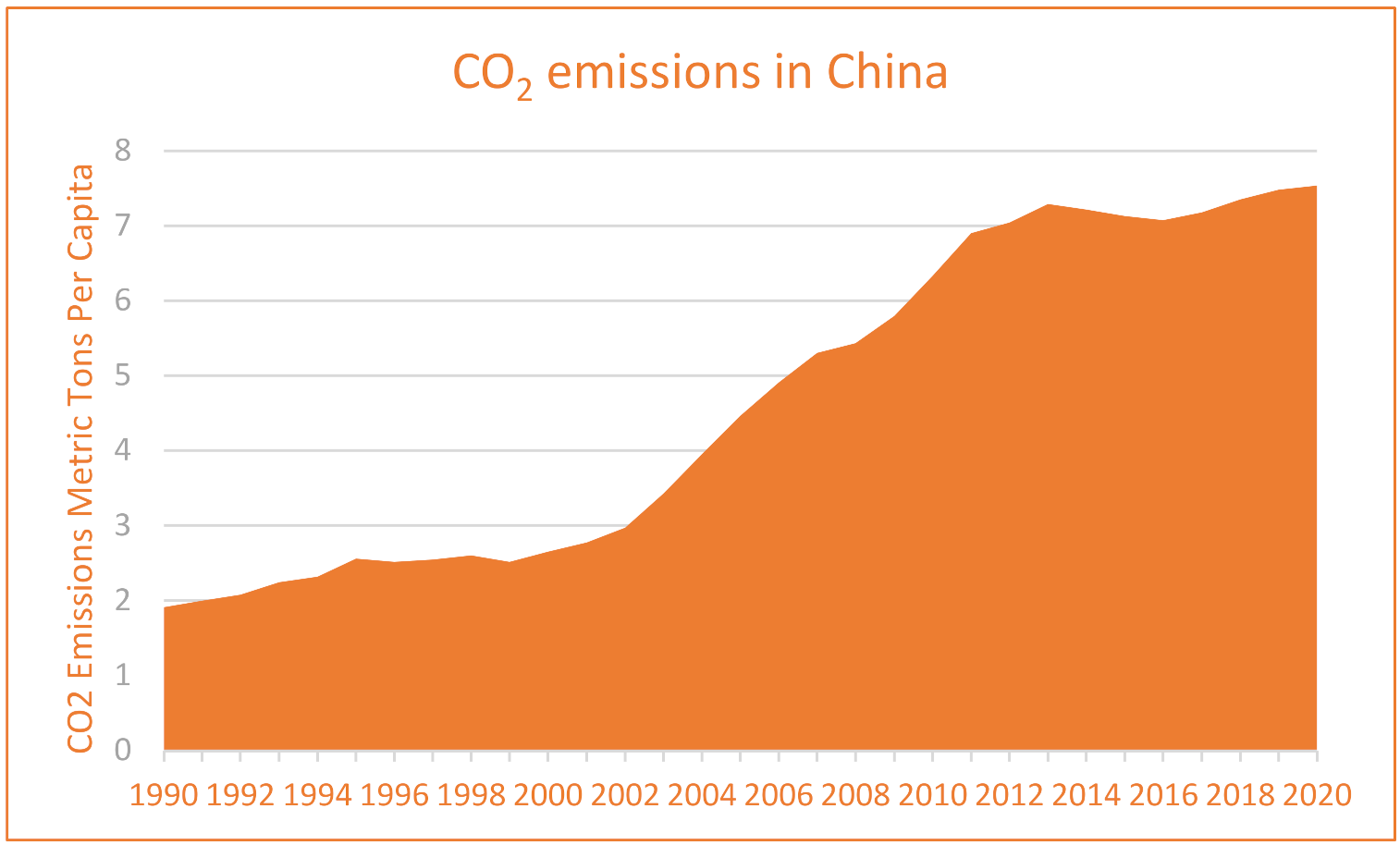
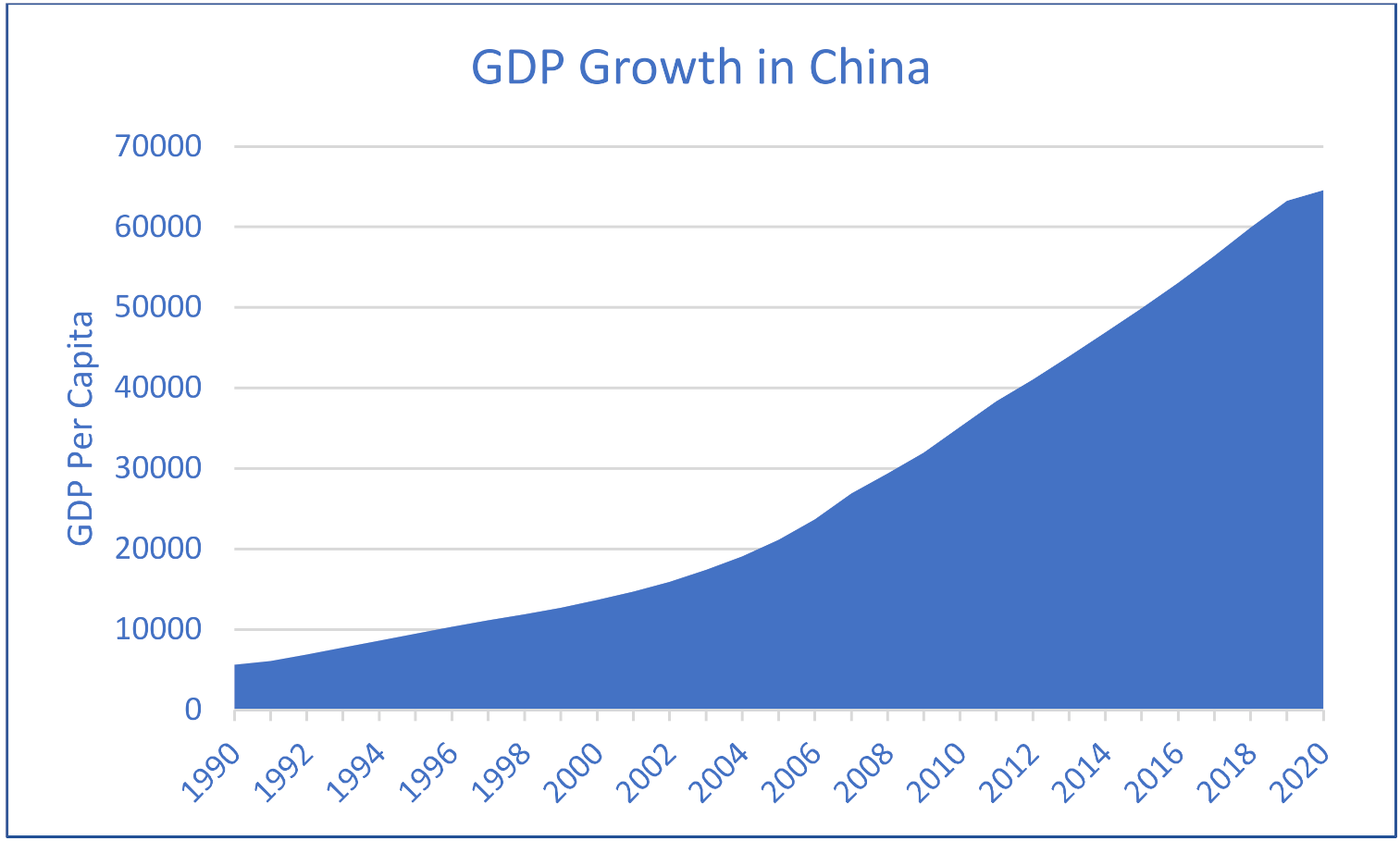
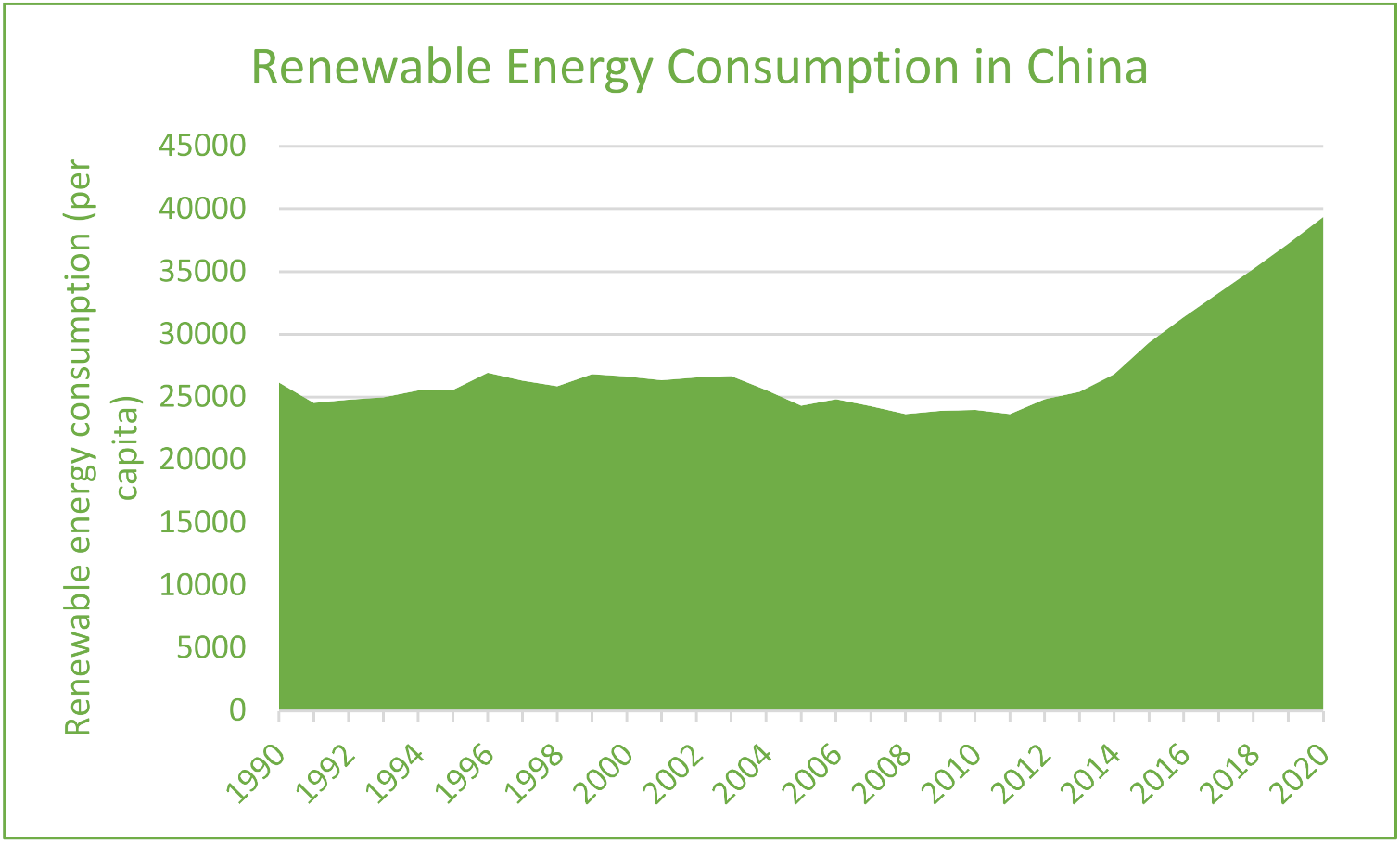
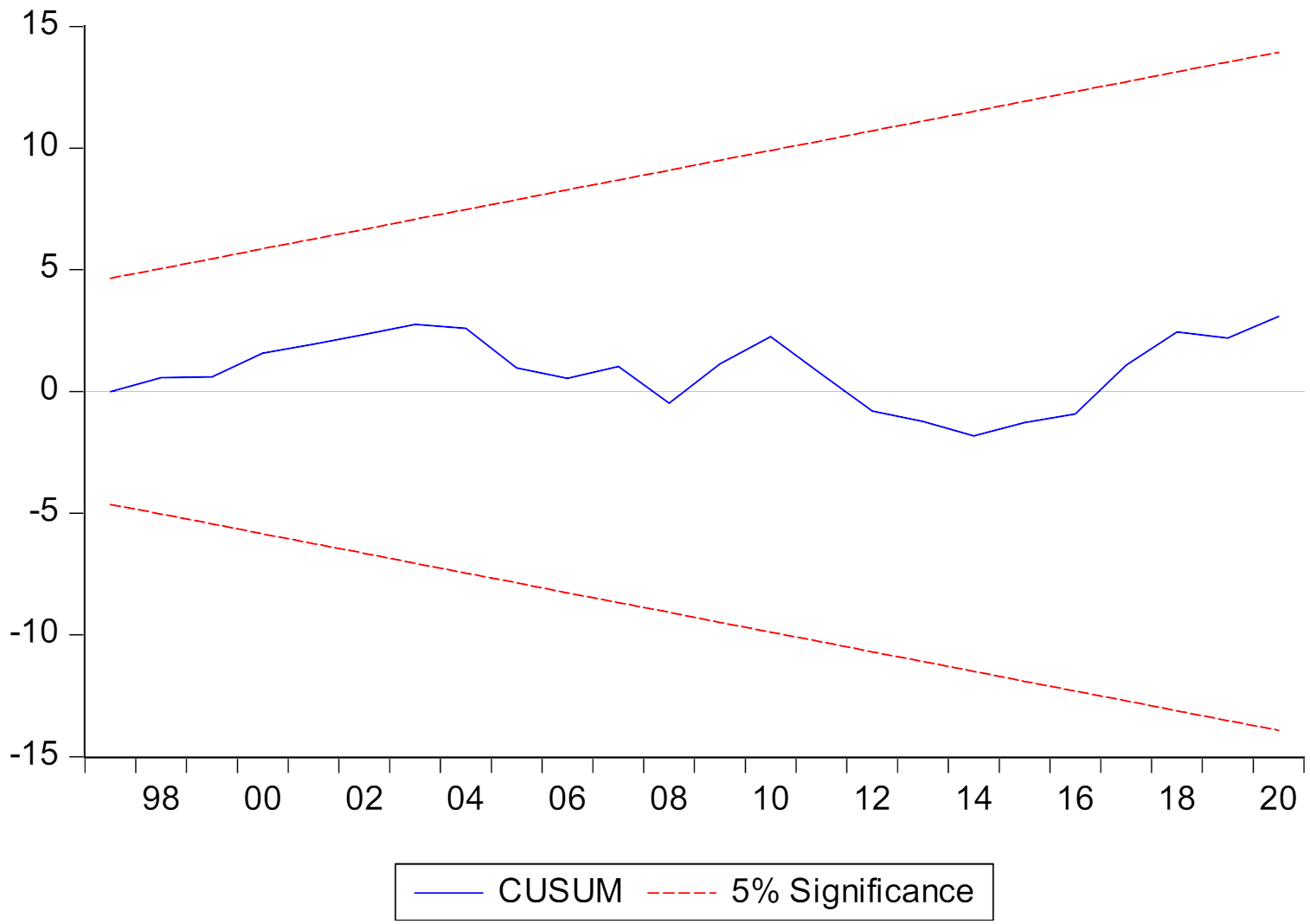
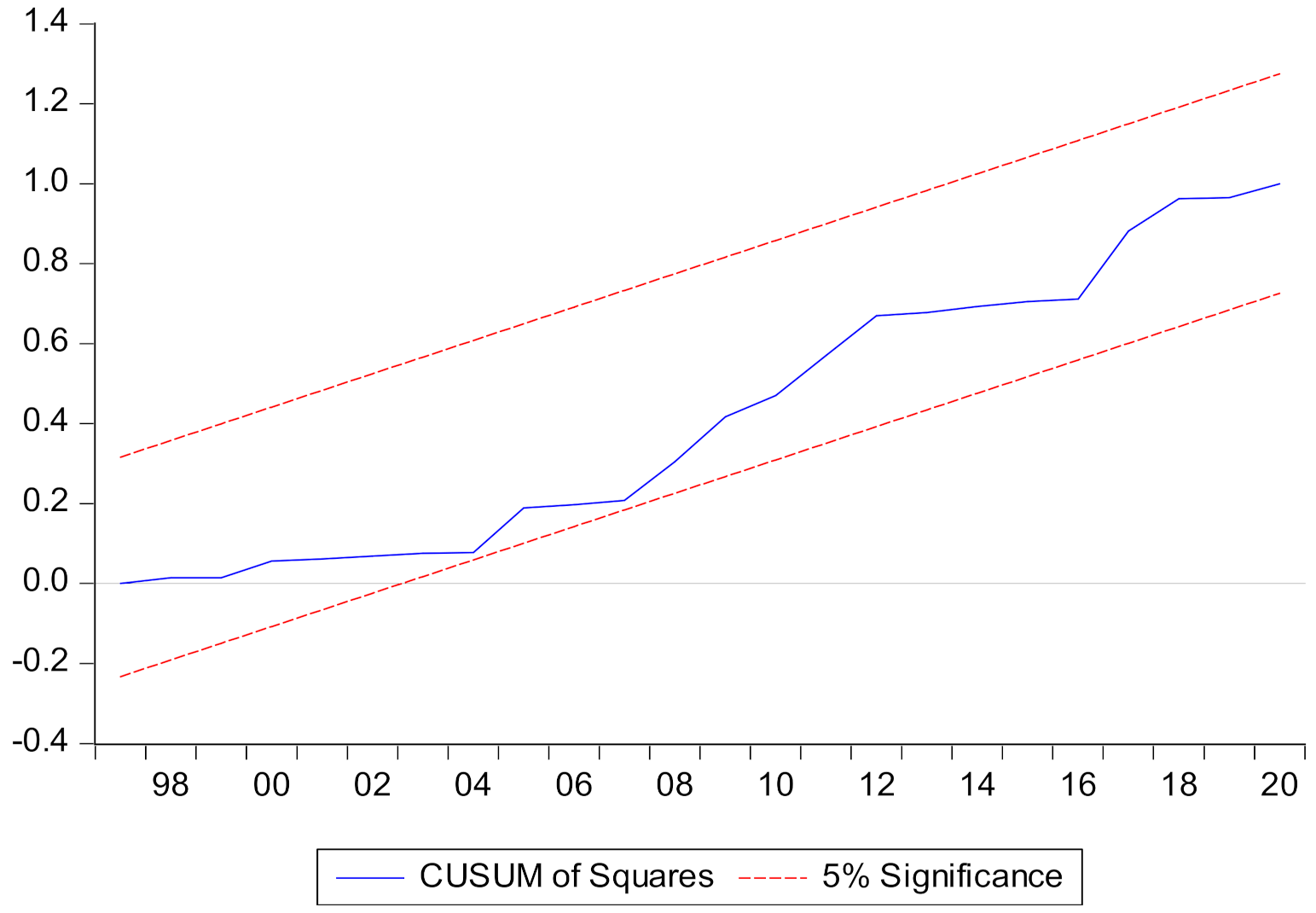
| ED | REC | GDP | T | P | |
|---|---|---|---|---|---|
| MEAN | 4.628 | 21.144 | 27,631.479 | 363,389.1 | 1.29 × 109 |
| S.D. | 2.147 | 8.679 | 19,062.425 | 481,685.4 | 81,136,228 |
| MIN | 1.914 | 11.338 | 5636.079 | 5832 | 1.14 × 109 |
| MAX | 7.538 | 34.083 | 64,581.412 | 1,393,815 | 1.41 × 109 |
| SKEW | 0.134 | 0.212 | 0.618 | 1.173 | −0.343 |
| KURT | 1.228 | 1.165 | 2.010 | 2.807 | 2.088 |
| Variable | Augmented Dickey-Fuller Test | Phillips-Perron Test | ||
|---|---|---|---|---|
| Level | 1st Difference | Level | 1st Difference | |
| ED | −2.012 | −3.328 * | −1.447 | −3.531 ** |
| GDP | −2.857 | −4.529 *** | −2.034 | −3.498 ** |
| GDP2 | −1.836 | −3.894 ** | −1.723 | −3.277 * |
| P | −0.463 | −4.552 *** | −0.439 | −4.430 *** |
| T | −1.264 | −3.291 * | 0.012 | −3.016 * |
| RE | −0.344 | −4.967 *** | −0.773 | −5.309 *** |
| F-Statistics (PSS) | 5.792 | |
|---|---|---|
| Critical-Values | ||
| Significance Levels | I (0) | I (1) |
| 10% | 2.977 | 4.260 |
| 5% | 3.576 | 5.065 |
| 1% | 5.046 | 6.930 |
| Short-Run Asymmetry | ||
|---|---|---|
| Variable | F-Statistic | p-Value |
| RE | 9.764 *** | 0.008 |
| Long-run Asymmetry | ||
| RE | 17.098 *** | 0.000 |
| Dependent Variable: ED | ||
|---|---|---|
| Variables | Coefficient Value | p-Value |
| Panel A: Short-Run Estimates | ||
| D (RE_NEG) | −0.660 | 0.118 |
| D (RE_NEG (−1)) | 0.007 | 0.192 |
| D (RE_NEG (−2)) | 1.291 *** | 0.016 |
| D (RE_POS) | −0.283 | 0.355 |
| D (RE_POS (−1)) | −0.506 * | 0.092 |
| D (GDP) | 2.155 *** | 0.001 |
| D (GDP2) | −1.893 *** | 0.008 |
| D (P) | 0.003 | 0.235 |
| D (P (−1)) | 0.722 * | 0.067 |
| D (ED) | 0.4776 ** | 0.034 |
| ECT | −0.548 ** | 0.017 |
| Constant | 0.0118 | 0.776 |
| Panel B: Long-Run Estimates | ||
| RE_NEG | 2.897 ** | 0.041 |
| RE_POS | −0.762 * | 0.081 |
| GDP | 2.314 *** | 0.000 |
| GDP2 | −0.809 * | 0.086 |
| P | 0.068 | 0.215 |
| T | −1.205 ** | 0.013 |
| Panel C: Diagnostic Test | ||
| Adjusted R2 | 0.687 | |
| F-Stat (p-value) | 18.390 *** (0.000) | |
| Portmanteau test (10) | 1.347 (0.265) | |
| JB Stat | 3.722 (0.144) | |
| Ramsey RESET | 1.794 (0.187) | |
| Parameters | Quantile v = 0.25 | Quantile v = 0.50 | Quantile v = 0.75 | |||
|---|---|---|---|---|---|---|
| Coefficient | p-Value | Coefficient | p-Value | Coefficient | p-Value | |
| GDP | 0.113 | 0.746 | 0.299 | 0.289 | 0.099 | 0.762 |
| GDP2 | −0.913 *** | 0.000 | −1.046 *** | 0.000 | −0.990 *** | 0.000 |
| P | 0.014 | 0.842 | 0.031 | 0.357 | 0.000 | 0.980 |
| RE | −0.692 *** | 0.000 | −0.526 *** | 0.000 | −0.535 *** | 0.001 |
| T | −1.328 | 0.681 | −4.155 | 0.149 | −4.227 | 0.144 |
Publisher’s Note: MDPI stays neutral with regard to jurisdictional claims in published maps and institutional affiliations. |
© 2022 by the authors. Licensee MDPI, Basel, Switzerland. This article is an open access article distributed under the terms and conditions of the Creative Commons Attribution (CC BY) license (https://creativecommons.org/licenses/by/4.0/).
Share and Cite
Jiang, Y.; Batool, Z.; Raza, S.M.F.; Haseeb, M.; Ali, S.; Zain Ul Abidin, S. Analyzing the Asymmetric Effect of Renewable Energy Consumption on Environment in STIRPAT-Kaya-EKC Framework: A NARDL Approach for China. Int. J. Environ. Res. Public Health 2022, 19, 7100. https://doi.org/10.3390/ijerph19127100
Jiang Y, Batool Z, Raza SMF, Haseeb M, Ali S, Zain Ul Abidin S. Analyzing the Asymmetric Effect of Renewable Energy Consumption on Environment in STIRPAT-Kaya-EKC Framework: A NARDL Approach for China. International Journal of Environmental Research and Public Health. 2022; 19(12):7100. https://doi.org/10.3390/ijerph19127100
Chicago/Turabian StyleJiang, Youxue, Zakia Batool, Syed Muhammad Faraz Raza, Mohammad Haseeb, Sajjad Ali, and Syed Zain Ul Abidin. 2022. "Analyzing the Asymmetric Effect of Renewable Energy Consumption on Environment in STIRPAT-Kaya-EKC Framework: A NARDL Approach for China" International Journal of Environmental Research and Public Health 19, no. 12: 7100. https://doi.org/10.3390/ijerph19127100
APA StyleJiang, Y., Batool, Z., Raza, S. M. F., Haseeb, M., Ali, S., & Zain Ul Abidin, S. (2022). Analyzing the Asymmetric Effect of Renewable Energy Consumption on Environment in STIRPAT-Kaya-EKC Framework: A NARDL Approach for China. International Journal of Environmental Research and Public Health, 19(12), 7100. https://doi.org/10.3390/ijerph19127100







